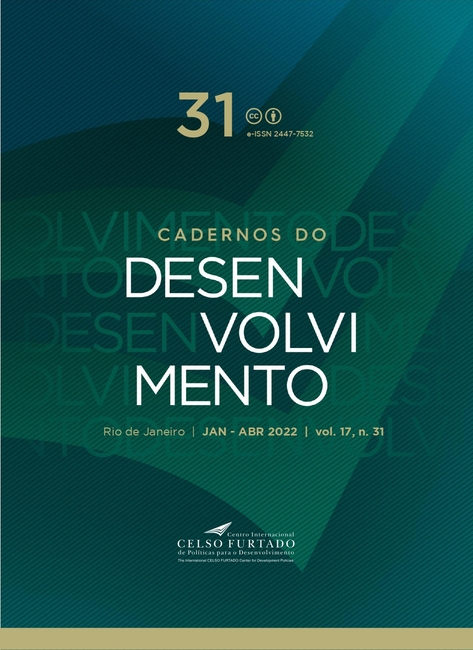Avaliação crítica da interpretação do mainstream acerca do fim da Era de Ouro do Capitalismo ocidental
Palavras-chave:
Era de Ouro, História do Pensamento Econômico, Economia Política, MonetarismoResumo
O presente artigo se propõe a expor e a analisar criticamente a interpretação do mainstream acerca do fim da Era de Ouro do capitalismo ocidental, fase de elevado crescimento econômico e baixas taxas de desemprego que seguiu a Segunda Guerra Mundial. Neste sentido a contribuição de Milton Friedman, no contexto de ascensão do movimento liberal, é entendida como sendo a principal referência, tanto para as interpretações dominantes para a estagflação dos anos 1970, quanto para o embasamento de políticas econômicas (que contribuem para o desempenho macroeconômico) das décadas subsequentes. Assim, por meio de revisão bibliográfica e de análise de estatísticas descritivas, o artigo aponta para o viés político do surgimento e da ascensão do arcabouço teórico monetarista, cuja dominância tanto refletiu quanto teve grande impacto sobre as condições do conflito distributivo do período analisado.Downloads
Referências
ABEL, A.; BERNANKE, B. Macroeconomics. Reading, MA: Addison-Wesley, 1998.
BARRO, R. J. E.; GORDON, D. Rules, Discretion and Reputation in a Model of Monetary Policy. Journal of Monetary Economics, n. 12, p. 101-121, 1983.
BARROS. L. A. “Grande Moderação” nos EUA: uma interpretação pós keynesiana. Instituto de Economia da UFRJ. Rio de Janeiro, 2018.
BARROS, L.; BASTIAN, E. F.; BASTOS, C. P. Inflação e desemprego nos Estados Unidos da América durante a Grande Moderação. Revista da Sociedade Brasileira de Economia Política, n. 55, jan.-abr. 2020.
COLANDER, D. et al. The changing face of mainstream economics. Review of Political Economy, v. 16, n. 4, p. 485-499, 2004.
DE LONG, J. B. America's peacetime inflation: the 1970s. Reducing inflation: Motivation and strategy. Chicago: Univ. of Chicago Press, 1997.
DEQUECH, D. Neoclassical, mainstream, orthodox, and heterodox economics. Journal of Post Keynesian Economics, v. 30, n. 20, p. 279-302, 2007.
FRIEDMAN, M. Comments on monetary policy. The Review of Economics and Statistics, v. 33, n. 3, p. 186-191, Aug. 1951.
FRIEDMAN, M. Inflationary Recession. Newsweek, n. 17, p. 92, Oct. 1966.
FRIEDMAN, M. The Role of Monetary Policy. The American Economic Review, v. 58, n. 1, p. 1-17, 1968.
FRIEDMAN, M. We Must Stand Firm against Inflation. Reader's Digest, p. 202–206, June 1970.
FRIEDMAN, M. Three Views of Nixonomics and Where It Leads. Newsweek, p. 74-75, 31 Jan. 1972.
FRIEDMAN, M. The Case for a Monetary Rule. Newsweek, p. 67, 7 Feb. 1972.
FRIEDMAN, M. Dealing with Discontent. Newsweek, n. 19, p. 69-70, Aug. 1974.
FRIEDMAN, M. Is Inflation a Curable Disease? University of Pittsburgh Graduate School of Business, Lecture, 5 December 1974.
FRIEDMAN, M. Inflation and Unemployment. Journal of Political Economy, n. 85, p. 451-472, 1976.
FRIEDMAN, M. Answering the Big Questions, by Milton Friedman and Paul A. Samuelson. Newsweek, n. 2, p. 80-81, May 1978.
FRIEDMAN, M. Capitalism and Freedom. London: Univ. of Chicago Press, 1982.
FRIEDMAN, M. Inflation: Retrospect and Prospect. Stanford Magazine, p. 38-40, Winter 1984.
FRIEDMAN, M. The Counter‐Revolution in Monetary Theory. Issues in Monetary Policy – “The Relationship between Money and the Financial Markets”, p. 171-183, 2012.
GOODFRIEND, M. How the World Achieved Consensus on Monetary Policy. Journal of Economic Perspectives, American Economic Association, v. 21, n. 4, p. 47-68, 2007.
GORDON, R. Price Inertia and Policy Ineffectiveness in the United States, 1890–1980. Journal of Political Economy, n. 90, p. 1087–1117, 1982.
GORDON, R. The History of the Phillips Curve: Consensus and Bifurcation. [S. l.]: Northwestern University; NBER; CEPR, 2011.
KYDLAND, F. E. E.; PRESCOTT, E. C. Rules Rather than Discretion: The Inconsistency of Optimal Plans. Journal of Political Economy, n. 85, p. 473-492, 1977.
MOORE, B. J. Horizontalists and verticalists: the macroeconomics of credit money. Cambridge: Cambridge Univ. Press, 1988.
NELSON, E.; NIKOLOV, K. UK Inflation in the 1970s and 1980s: the Role of Output Gap Mismeasurement. Journal of Economics and Business, v. 55, n. 4, p. 353-370, 2003.
NELSON, E. The Great Inflation of the Seventies: What Really Happened? B. E. Advances in Macroeconomics, n. 5, art. 3, 2005.
PALLEY, T. I. Milton Friedman and the monetarist counter-revolution: a re-appraisal. Eastern Economic Journal, v. 19, n. 1, p. 71-81, 1993.
PANITCH, L.; GINDIN, S. The making of global capitalism: the political economy of the American Empire. London; New York: Verso, 2012.
PHILLIPS-FEIN, Kim. Invisible hands: The making of the conservative movement from the New Deal to Reagan. Yayasan Obor Indonesia, 2009.
PIVETTI, M. An essay on the monetary theory of distribution. London: Macmillan, 1991.
ROMER, C. D.; ROMER, D. H. The Evolution of Economic Understanding and Postwar Stabilization Policy. Rethinking Stabilization Policy, Federal Reserve Bank of Kansas City, p. 11-78, 2002.
TAYLOR, J. B. The Great Inflation, the Great Disinflation, and Policies for Future Price Stability. In: BLUNDELL-WIGNALL, A. (Ed.). Inflation, Disinflation and Monetary Policy. Sydney: Ambassador Press, 1992.
TAYLOR, J. B. Discretion versus policy rules in practice. In: Carnegie-Rochester conference series on public policy. North-Holland: [S. n.], 1993.
TOBIN, J. et al. Stabilization policy ten years after. Brookings Papers on Economic Activity, v. 1980, n. 1, p. 19-89, 1980.
Downloads
Publicado
Como Citar
Edição
Seção
Licença
Autores que publicam nesta revista concordam com os seguintes termos:- Autores mantém os direitos autorais e concedem à revista o direito de primeira publicação, com o trabalho simultaneamente licenciado sob a Licença Creative Commons Attribution que permite o compartilhamento do trabalho com reconhecimento da autoria e publicação inicial nesta revista;
- Autores têm autorização para assumir contratos adicionais separadamente, para distribuição não-exclusiva da versão do trabalho publicada nesta revista (ex.: publicar em repositório institucional ou como capítulo de livro), com reconhecimento de autoria e publicação inicial nesta revista;
- Autores têm permissão e são estimulados a publicar e distribuir seu trabalho online (ex.: em repositórios institucionais ou na sua página pessoal) a qualquer ponto antes ou durante o processo editorial, já que isso pode gerar alterações produtivas, bem como aumentar o impacto e a citação do trabalho publicado (Veja O Efeito do Acesso Livre).


